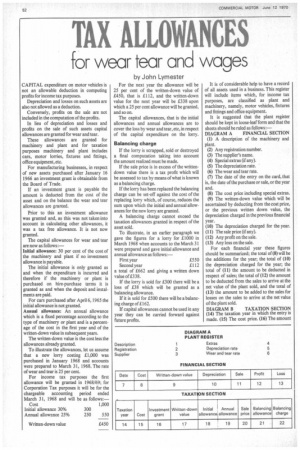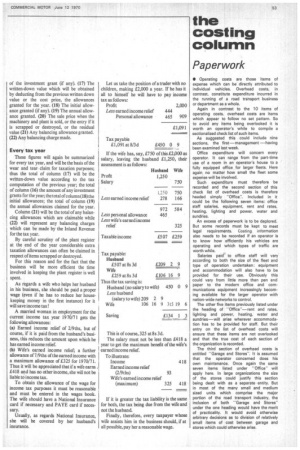TAX ALLOWANCES
Page 54

Page 55

If you've noticed an error in this article please click here to report it so we can fix it.
for wear tear and wages
by John Lymester
CAPITAL expenditure on motor vehicles is not an allowable deduction in computing profits for income tax purposes.
Depreciation and losses on such assets are also not allowed as a deduction.
Conversely, profits on the sale are not included in the computation of the profits.
In lieu of depreciation and losses and profits on the sale of such assets capital allowances are granted for wear and tear.
These allowances are granted for machinery and plant and for taxation purposes machinery and plant includes cars, motor lorries, fixtures and fittings, office equipment, etc.
For manufacturing businesses, in respect of new assets purchased after January 16 1966 an investment grant is obtainable from the Board of Trade.
If an investment grant is payable the amount is deducted from the cost of the asset and on the balance the wear and tear allowances are granted.
Prior to this an investment allowance was granted and, as this was not taken into account in calculating other allowances, it was a tax free allowance. It is not now granted.
The capital allowances for wear and tear are now as follows:—
Initial allowance: 30 per cent of the cost of the machinery and plant if no investment allowance is payable.
The initial allowance is only granted as and when the expenditure is incurred and therefore if the machinery or plant is purchased on hire-purchase terms it is granted as and when the deposit and instalments are paid.
For cars purchased after April 6, 1965 the initial allowance is not granted.
Annual allowance: An annual allowance which is a fixed percentage according to the type of machinery or plant and is a percentage of the cost in the first year and of the written-down value in subsequent years.
The written-down value is the cost less the allowances already granted.
To illustrate the allowances, let us assume that a new lorry costing £1,000 was purchased in January 1968 and accounts were prepared to March 31, 1968. The rate of wear and tear is 25 per cent.
For income tax purposes the first allowance will be granted in 1968/69; for Corporation Tax purposes it will be for the chargeable accounting period ended March 31, 1968 and will be as follows:—
Cost 1,000 Initial allowance 30% 300 Annual allowance 25% 250 550 Written-down value £450 For the next year the allowance will be 25 per cent of the written-down value of £450, that is £112, and the written-down value for the next year will be £338 upon which a 25 per cent allowance will be granted, and so on.
The capital allowances, that is the initial allowances and annual allowances are to cover the loss by wear and tear, etc, in respect of the capital expenditure on the lorry.
Balancing charge
If the lorry is scrapped, sold or destroyed a final computation taking into account the amount realized must be made.
If the sale price is in excess of the writtendown value there is a tax profit which will be assessed to tax by means of what is known as a balancing charge.
If the lorry has been replaced the balancing charge can be set-off against the cost of the replading lorry which, of course, reduces the sum upon which the initial and annual allowances for the new lorry are granted.
A balancing charge cannot exceed the taxation allowances granted in respect of the asset sold.
To illustrate, in an earlier paragraph we gave the figures for a lorry for £1000 in March 1968 when accounts to the March 31 were prepared and gave initial allowance and annual allowance as follows:— First year £550 Second year £112 a total of £662 and giving a written down value of £338.
If the lorry is sold for £300 there will be a loss of £38 which will be granted as a balancing allowance.
If it is sold for £500 there will be a balancing charge of £162.
If capital allowances cannot be used in any year they can be carried forward against future profits.
It is of considerable help to have a record of all assets used in a business. This register will include items which, for income tax purposes, are classified as plant and machinery, namely, motor vehicles, fixtures and fittings and office equipment.
It is suggested that the plant register should be kept in loose-leaf form and that the sheets should be ruled as follows:— DIAGRAM A FINANCIAL SECTION (1) A description of the machinery and plant.
(2) Any registration number.
(3) The supplier's name.
(4) Special extras (if any).
(5) The depreciation rate.
(6) The wear and tear rate.
(7) The date of the entry on the card, that is, the date of the purchase or sale, or the year and.
(8) The cost price including special extras.
(9) The written-down value which will be ascertained by deducting from the cost price, or the previous written down value, the depreciation charged in the previous financial year.
(10) The depreciation charged for the year.
(11) The sale price (if any).
(12) Any profit on the sale.
(13) Any loss on the sale.
For each financial year these figures should be summarized; the total of (8) will be
the additions for the year; the total of (10)
the depreciation charged for the year; the total of (11) the amount to be deducted in respect of sales; the total of (12) the amount to be deducted from the sales to arrive at the net value of the plant sold, and the total of (13) the amount to be added to the sales for losses on the sales to arrive at the net value of the plant sold.
DIAGRAM B TAXATION SECTION
(14) The taxation year in which the entry is made. (15) The cost price. (16) The amount of the investment grant (if any). (17) The written-down value which will be obtained by deducting from the previous written down value or the cost price, the allowances granted for the year. (18) The initial allowance granted (if any). (19) The annual allowance granted. (20) The sale price when the machinery and plant is sold, or the entry if it is scrapped or destroyed, or the residual value (21) Any balancing allowance granted. (22) Any balancing charge made.
Every tax year These figures will again be summarized for every tax year, and will be the basis of the wear and tear claim for taxation purposes; thus the total of column (17) will be the written-down value according to the tax computation of the previous year; the total of column (16) the amount of any investment grants for the year; the total of column (18) the initial allowances; the total of column (19) the annual allowances claimed for the year. Column (21) will be the total of any balancing allowances which are claimable while (22) will represent any balancing charges which can be made by the Inland Revenue for the tax year.
By careful scrutiny of the plant register at the end of the year considerable extra taxation allowances can often be claimed in respect of items scrapped or destroyed.
For this reason and for the fact that the business will be more efficient the time involved in keeping the plant register is well spent.
As regards a wife who helps her husband in his business, she should be paid a proper
wage (even if he has to reduce her housekeeping money in the first instance) for it will save income tax!
A married woman in employment for the current income tax year 1970/71 gets the following allowances: (a) Earned income relief of 2/9ths, but of course, if it is paid from the husband's business, this reduces the amount upon which he has earned income relief.
(13) Wife's earned income relief; a further allowance of 7/9 ths of the earned income with a maximum allowance of £325 for 1970/71. Thus it will be appreciated that if a wife earns £418 and has no other income, she will not be liable to income tax.
To obtain the allowance of the wage for income tax purposes it must be reasonable and must be entered in the wages book. The wife should have a National Insurance card if necessary and PAYE card if necessary.
Usually, as regards National Insurance, she will be covered by her husband's insurance. Let us take the position of a trader with no children, making £2,000 a year. IT he has it all to himself he will have to pay income tax as follows: Profit 2,000
Less earned income relief 444
If it is greater the tax liability is the same for both, the tax being due from the wife and not the husband.
Finally, therefore, every taxpayer whose wife assists him in the business should, if at all possible, pay her a reasonable wage.
























































































































